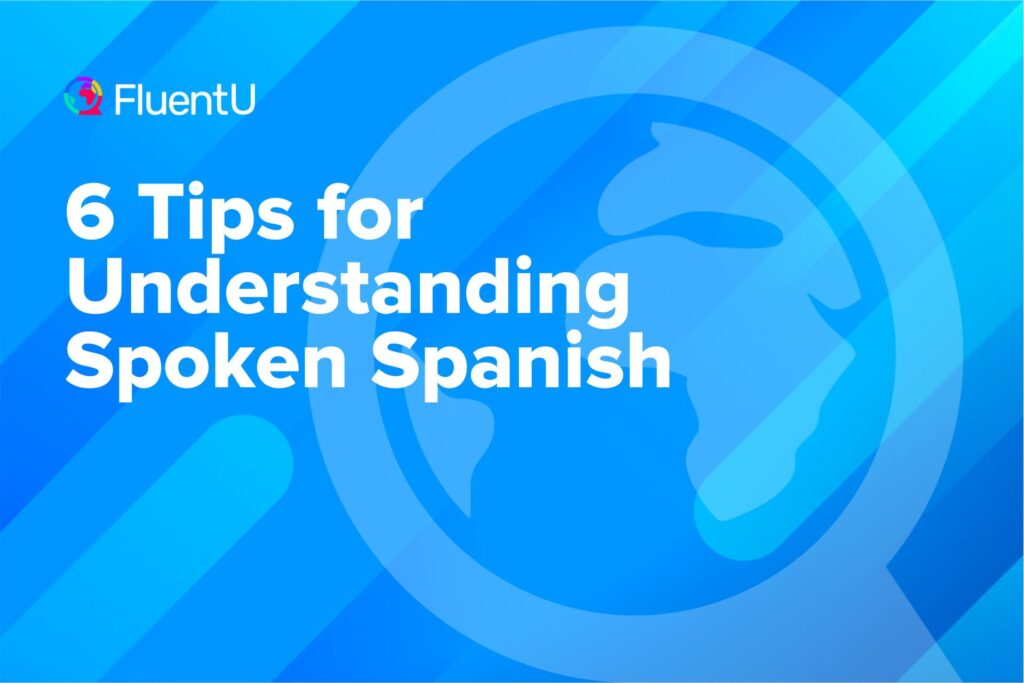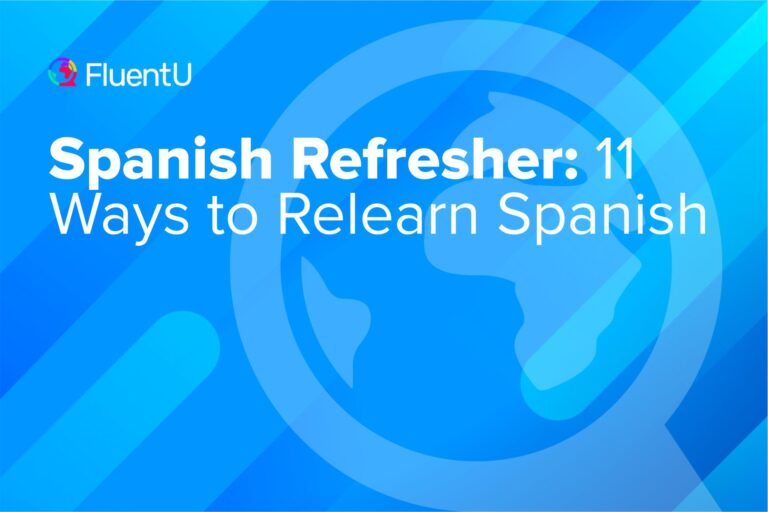6 Tips for Understanding Spoken Spanish

What if the native Spanish speaker throws down words so fast or has an accent that you’re totally unfamiliar with? What if they whip out slang from a country you’ve never visited or what if you just forget everything and freeze?
At times we’ve all felt a little less than confident when speaking our second language. So in this post, I’ll share my 6 go-to tips that helped me understand Spanish speakers better.
Download: This blog post is available as a convenient and portable PDF that you can take anywhere. Click here to get a copy. (Download)
1. Learn more about the Spanish culture
There’s much more to communication than just words. While the dictionaries and vocabulary lists do teach a lot of real Spanish, it’s nearly impossible for them to keep up with all of the extrinsic influences on them which can definitely affect the way they’re used and understood.
There’s just so much to the language that you simply need to read into the culture to learn.
That being said, Spanish is the official language in the highest number of countries around the world (with more than 500 million speakers!) so this step is especially important when learning to understand it.
For example, in Spain, a crosswalk is often referred to as paso de cebra, which translates to something like “zebra crossing.” They also pronounce some letters differently than most other Spanish-speaking countries, such as the c or z, which you may think sound similar to a lisp.
Another thing to consider is how much cultural references come into play. Think about how much your own country’s culture comes up in your everyday conversations, from its history to its foods to its traditions.
That’s why, even if you know Spanish, you may not know what a quinceañera or flamenco is. Quinceañera, literally “fifteen year old,” can be used in reference to a huge party that girls have on their 15th birthdays, which is very traditional in Mexico and other Latin American cultures. Meanwhile, flamenco is a dance that’s very popular in southern Spain.
Whether you’re traveling to Ecuador, Peru, Cuba or Spain, learning about the area’s culture will definitely help your comprehension skills of the local language and how it’s used in everyday conversations.
Researching the foods, history and traditions, as well as learning the slang and listening to the accents, will greatly expand your understanding.
Here’re some of the resources you can use to learn more about the culture of Spanish-speaking countries:
- Así Hablamos, a website much like Urban Dictionary that defines slang, modern terms and other parts of conversation that go beyond our standard dictionaries.
- YouTube, where you’re likely to find countless videos focusing on these types of things.
- Audio resources. Listen to radio stations, podcasts and any other audio from your destination country.
- Find a language learning partner! Try to make a friend who’s a part of the Spanish-speaking culture you’re trying to pursue. If that’s not possible, you can always try My Language Exchange or find an online tutor.
- Find a tutor. You can have a casual conversation with a tutor. You can chat about your own lives, cultures and traditions quite a bit and get to know each other in the process of teaching and learning. To find professional tutors who suit all of your unique interests, needs and preferences, start by searching on Verbling—quite possibly the biggest name in online language tutoring. To find someone local, opt for Wyzant—a great service that helps you find tutors close to home.
This will be one of the most fun parts of studying, and just by learning a little background on a country, you can greatly increase your comprehension and avoid having to feel like your grandma trying to decode text messages while you’re there.
2. Pick up the pronunciation of the local accent or dialect
Many people can read Spanish, but when it comes to listening to it, they find themselves having a hard time understanding something they could easily read on paper, or vice versa.
So, give more vocal, communicative lessons a shot to try and get your ears caught up with local accents and dialects. Yet again, you’ll want to keep your destination country or intended use of Spanish in mind. Pick up the accent or dialect that’ll be most useful to you.
You’d be astounded by how lack of familiarity with any place’s local accent or dialect can affect your understanding. You may well miss the meaning of most sentences in the Dominican Republic if you’ve never heard a native Dominican speak before.
You can try watching TV in Spanish with English subtitles. There are tons of programs available in Spanish, such as telenovelas, cartoons and the news. You may even find dubs of your favorite Hollywood movies!
You can also do listening exercises on YouTube. One YouTube resource you can check out is the short series of listening exercises called “Learn Spanish in 20 Days.”
Even though some people may make it seem like it’s nothing, many who are bilingual have been learning since they were in grade school. Learning and perfecting a language can take months or even years!
3. Learn grammar inside and out
Sometimes, even though it may seem trivial, putting a word out of order or missing a punctuation mark can completely change the meaning of a sentence.
Native speakers of any language break the rules of grammar in casual speech, or deliberately change them around or play with them to get across different messages. That’s why you’ll need to know grammar inside and out, if you want to catch everything everyone’s saying.
Even though you may know thousands of words in the language, if you don’t know how to properly—and improperly—put them together, understanding the language will be a struggle.
Luckily, Spanish grammar isn’t too far off from English, and in some ways it’s even more straightforward. I’m willing to bet that this won’t be a terribly difficult point to master, especially considering that there are countless resources to help.
Here are a few of them you can take a look at:
- Find a used Spanish grammar book on Amazon that suits your current level of grammar and overall comprehension. It can cost you only a few cents if you’re a smart shopper.
- Get an online tutor. As we noted earlier, there are many places where you can find Spanish tutors. Verbling is just one example of a high-quality tutoring site where you can even find tutors from specific Spanish-speaking countries, to better meet your personal Spanish learning goals.
4. Soak up the spelling
Knowing how the spelling works is key. Getting to terms with the sounds that each of the Spanish letters produces will help solidify your overall understanding. You’ll hear someone say a completely unknown word—but your brain will be able to translate those Spanish sounds into letters and piece together the word itself.
Once you can more or less envision how that unknown word is spelled, there’s a great chance you’ll remember its definition, recognize it as a cognate (sounding similar to something in English) or recognize prefixes, suffixes and roots that you already know from other Spanish and English words.
Luckily, this is one of the easiest parts to learn when you already speak English fluently. For starters, English and Spanish both use almost exactly the same alphabet, which means that Spanish is already significantly easier and less intimidating to learn than many other languages.
There are languages in which spelling is intuitive, where most letters and vowels only make one sound each, and you can almost always succeed with a little guesswork. Spanish is fortunately one of these. That’s why this is an exceptionally good tip for this particular language.
To get yourself started (or familiarized), the Internet has a ton of resources that you can check out right now, such as this brief introductory course available for free online.
5. Work on your vocabulary
It’s always a good idea to make sure you know exactly how the words are pronounced, spelled and used in context. It’ll make fluent understanding happen more quickly and make you more likely to remember them in the future.
When learning vocabulary words, there are many different ways to approach it. This all boils down to your personal goals. While you should strive to learn vocabulary covering a wide variety of areas, you can really dig in and focus more intensely on the vocabulary that you’ll encounter more often in your life.
With this in mind, here are a few tips:
- Study vocabulary words in groups. Working with thematically related words will give you more context for remembering them all. You’ll build associations between them, which is perfect for learning and retaining everything. For example, you could try learning tons of fruit names at once, or words for common things around the house.
- Use a nice variety of methods to keep yourself entertained. Don’t just stick to vocab lists or the same old deck of flashcards. Try out different flashcard apps, learning games and more. Keep it fun and fresh, and your brain will respond better.
- Focus on words that you use often, and for things you see and do every day. This will get you speaking quickly, so making your own lists isn’t a bad idea!
- Focus on words related to your profession, hobbies and interests. For example, if you’re a nurse and want to communicate with Spanish-speaking patients, learn word sets for things like body parts, commands and treatments first.
- Learn vocabulary words naturally through Spanish media. Consuming authentic Spanish content—like YouTube videos, Netflix shows, movies, podcasts, etc.—is one of the best ways to pick up tons of new relevant words. And it’s not hard to do. For example, you can use FluentU to watch tons of level-appropriate videos that use only native, authentic Spanish with subtitles that let you click on words you don’t know so you can learn them. There’s also a FluentU Chrome extension that makes the subtitles on any Spanish Netflix show/movie or YouTube video clickable, and the FluentU YouTube channel has tons of deep-dive video lessons using TV shows. Like this one from The Big Bang Theory:
Once you’ve got enough words, it’s definitely not a bad idea to start studying synonyms and words related to ones you already know.
All in all, knowing more vocabulary will likely make things clearer for you in everyday conversation, considering the variety of words we use in our daily speech.
6. Keep multiple translations in mind
Though another key thing to remember is that some words and phrases don’t always translate the way you’d assume.
For instance, there’s a good number of ways to say the verb “to poop” in Spanish, one of them being ir de cuerpo, which more or less translates to “to go the body” or “to leave from the body,” which could probably be a little confusing upon hearing it for the first time—but once it’s been pointed out to you, it’ll totally make sense from then on out. So, make sure that you see any new vocabulary word in a variety of different contexts.
That’s why it’s important to keep your words active so you will remember where and how to use them. Think of how much your vocabulary level went down after you finished college, or took an extended holiday from working and studying, and weren’t reading complex things on the regular. In a matter of weeks (even days!) your vocabulary can start to slip away from you, so consistent practice is a must.
Naturally, if you only learn the words once and never use them, you’ll probably forget them. Keeping some Spanish active in your daily or weekly study routine is a great way to keep yourself fresh and quick.
A few ways to do this that will barely take time from your life are to:
- Update your personal libraries with Spanish listening and reading material. If you’re not aware of what’s good in the Spanish-language entertainment world, check out Shazam’s Top Spanish Songs for music, and maybe even try to get into some telenovelas!
- Find someone to practice with. If that’s not exactly easy where you’re living, there are a few websites that will come in handy. On My Language Exchange, you can find a pen pal along with plenty of other helpful tools.
What it Means to Truly Understand Spanish
Some may say you need to know X amount of words, have taken courses A, B and C or have passed this or that exam, but in the end it’s really a matter of what understanding means to you and your own personal objectives.
If you’re dying to speak conversationally with people in restaurants, bars and hotels, you don’t need to lament your lack of understanding at a scientific conference. If you’re planning to work among the Spanish-speaking scientific community, then the true meaning of understanding for you might well be defined during that conference.
In essence, the meaning of understanding is up to you entirely!
Be sure to ask yourself a few questions before setting your goals for understanding Spanish, such as:
- What do you plan on using Spanish for?
- With whom will you be communicating?
- How much time and effort are you willing and able to dedicate?
Once you have an idea about what you’re aiming for, it’s time to put your plan in motion.
Why Can’t I Understand Spanish?
Practice makes perfect, but it can sometimes be hard to get the right practice.
It can be difficult to find someone to actually speak Spanish with, especially if you don’t live in a Spanish-speaking country. And while reading Spanish language textbooks from cover to cover does teach us a lot about the language, it can be a little hard to get our ears attuned to Spanish as it works in ordinary, everyday speech.
If you relate to this, look no further.
You might be surprised to hear that there are tons of free resources, helpful lessons and strategies out there designed to improve your understanding of naturally spoken Spanish, and you can find something that connects with your specific needs to get you where you want to be.
So, never lose hope in your understanding abilities. Just use the above tips that’ll help you take your Spanish to the next level.
Here are my go-to tips to fluent understanding!
It may take some time, but remember that you’ll improve every week if you keep it up. Everything you need is right in front of you!
Happy studies and ¡buena suerte! (good luck!)
Download: This blog post is available as a convenient and portable PDF that you can take anywhere. Click here to get a copy. (Download)







